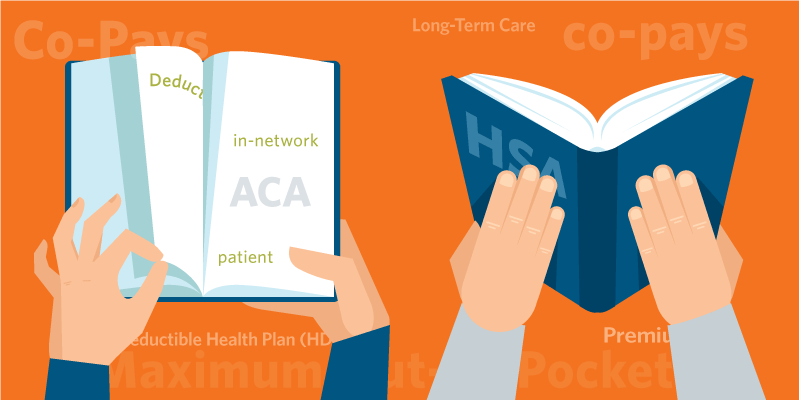
Literacy requires common language and understanding—how to increase your employees’ health literacy

This post is the second in a series about the importance of health education and literacy in the evolution and success of the nation’s health care system. Employers play a significant part in that success, as a reliable and trusted source of health information to their employees. This series aims to give companies tips and best practices to engage employees in health education and build health literacy.
In most other shopping decisions, the buyer knows what she’s buying and the seller knows he’s dealing with an informed buyer. Not so in health care. Most agree that the difficulties of health care purchasing begin with this imbalance of information.
Part of the solution is language. To navigate smoothly and with confidence, we need fluency in English—which many of us lack—as well as fluency in the words used by medical and insurance professionals. The stakes are real. Low health literacy contributes to poorer health outcomes and inefficient use of health care services and partially explains the disparities in health outcomes.
As a trusted source of health and financial information, employers have a vital role to play.
Make simple language a priority
As industry professionals, we know what a deductible is and its importance in selecting and using a medical plan effectively. However, employees’ understanding is completely different. When it comes to evaluating plans during enrollment, they’re not likely asking themselves, “Which services count toward my deductible?” or “How do my family members’ costs help satisfy the family deductible?”
There are three ways employers can be deliberate with language and help employees understand the complex health care system.
- Standardize the meaning of terms, then align the words: Although the newly mandated Summary of Benefits and Coverage—a simple standard form—helps standardize terms across the industry, it is imperfect. If your employees can choose between a high-deductible health plan—so that legally an HSA can be paired with it—and any other plan design, consider aligning the meaning of a single and family deductible. There shouldn’t be two answers to the question: If I satisfy the family deductible with my own health care expenses, will my husband’s costs be subjected to the individual deductible? Consider, too, whether prescription expenses should be part of satisfying the deductible in your PPO plan. In the same vein, don’t settle for several different meanings of an out-of-pocket maximum across your plans. Even if you’re super clear in your definitions, it’s impossible to compare apples to oranges. Nothing undermines the effort of shopping for insurance more than a shifting definition of financial risk.
- Check reading levels. Both legally required notices and plan information ask too much of individuals’ comprehension and understanding. Simplify language wherever you can and provide materials that are easily accessible to all readers. Remember, it’s not patronizing to send engineers information that’s written at an eighth-grade reading level—it’s just kind.
- Advocate and influence the broader system. We can also advocate for employees with our health insurance partners to use standardized terms, so the ecosystem works in harmony. Slip that demand into your next renewal as an imperative. Going a step further, the ERISA Advisory Council has recommended that the Department of Labor use its influence to push insurers to create a standard EOB. Employers can lend their voices to support that recommendation.
Support every chance to engage in the health care system
We all have an amazing amount of health resources at our fingertips. People are paying attention and tracking their own health in ways that would have been unthinkable in the past. Patient sharing sites such as PatientsLikeMe not only grow consumers’ confidence, but also empower them to make changes to their treatment. Whether physicians’ skepticism about such channels is justified remains an important, yet unexplored area of study. Meanwhile, employers can foster the confidence that comes from self-care, self-tracking, using cost estimators, following preventive standards and calling a health care advocate. Confidence is a transferable attitude—one doctor visit, one diagnosis at a time.
- Support the learning curve. All health care decisions contribute to employees’ personal knowledge base—each small action informs the next. Consciously or not, each interaction is a chance to practice using terms and grow health literacy. Make sure you promote health plan comparison and health care shopping tools—and find ways to recognize and celebrate participation.
- Meet people where they are. Acknowledge that your workforce isn’t a monolithic group, and respect employees’ differences in health status, condition management, life stage and even financial levels. This needn’t foster an “us versus them” perception, though. Rather, segmenting your employee population and targeting your health education messages accordingly can increase employee engagement by making them feel a personal connection to your programs.
Literacy is the foundation of citizenship—the ability to advocate for oneself, family and community. Health literacy is a responsibility and a requirement for all Americans. We can’t transform our health care system if employees don’t participate. It won’t be a simple fix; it begins with small steps and an openness to new solutions. As an employer, you can facilitate enormous change.
Work with Us
We partner with organizations that value their people first. Let’s talk.
